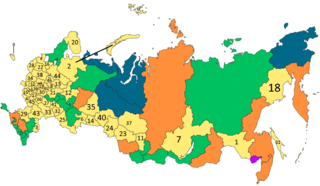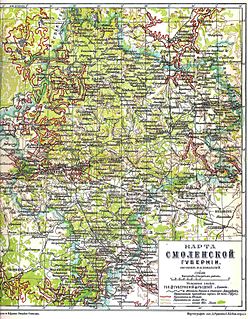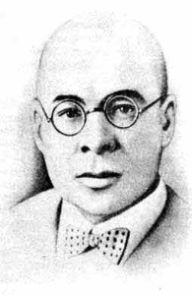
The Republics of the Union of Soviet Socialist Republics or Union Republics were the ethnically based proto-states of the Soviet Union. For most of its history, the USSR was a highly centralized state; the decentralization reforms during the era of Perestroika ("Restructuring") and Glasnost ("Openness") conducted by Mikhail Gorbachev are cited as one of the factors which led to the dissolution of the USSR in 1991.

Smolensk is a city and the administrative center of Smolensk Oblast, Russia, located on the Dnieper River, 360 kilometers (220 mi) west-southwest of Moscow. Population: 326,861 (2010 Census); 325,137 (2002 Census); 341,483 (1989 Census).

The Byelorussian Soviet Socialist Republic, also commonly referred to in English as Byelorussia, was a federal unit of the Soviet Union (USSR). It existed between 1920 and 1922, and from 1922 to 1991 as one of fifteen constituent republics of the USSR, with its own legislation from 1990 to 1991. The republic was ruled by the Communist Party of Byelorussia and was also referred to as Soviet Byelorussia by a number of historians.

At the top level of administration, Belarus is divided into six regions and the city of Minsk, which has a special status being the capital of Belarus. Minsk is also the capital of Minsk Region.

Velizh is a town and the administrative center of Velizhsky District in Smolensk Oblast, Russia, located on the bank of the Western Dvina, 134 kilometers (83 mi) from Smolensk, the administrative center of the oblast. Population: 7,620 (2010 Census); 8,343 (2002 Census); 9,146 (1989 Census).

An Oblast is a type of federal subject of the Russian Federation.

The Belarusian People's Republic, historically referred to as the White Ruthenian Democratic Republic was a failed attempt to create a Belarusian state on the territory controlled by the German Imperial Army during World War I. The BNR existed from 1918 to 1919.

The Soviet westward offensive of 1918–1919 was part of the campaign by the Russian Soviet Federative Socialist Republic into areas abandoned by the Ober Ost garrisons that were being withdrawn to Germany following that country's defeat in World War I. The initially successful offensive against the Republic of Estonia ignited the Estonian War of Independence which ended with the Soviet recognition of Estonia. The war against Republics of Latvia and Lithuania was more successful for the Soviets, and resulted in the Latvian Socialist Soviet Republic and Lithuanian Soviet Socialist Republics being established. In Belarus, the Belarusian People's Republic was conquered and the Socialist Soviet Republic of Byelorussia proclaimed.

The Lithuanian–Byelorussian Soviet Socialist Republic or Litbel (Lit-Bel) was a Soviet socialist republic that existed within the territories of modern Belarus and eastern Lithuania for approximately five months during 1919. It was created after the merger of the Lithuanian Soviet Socialist Republic and the Socialist Soviet Republic of Byelorussia. The republic was dissolved after the Polish Army took over its claimed territory of eastern Lithuania during the Polish–Soviet War.

Smolensk Governorate, or the Government of Smolensk, was an administrative division of the Tsardom of Russia, the Russian Empire, and the Russian SFSR, which existed, with interruptions, between 1708 and 1929.
Belarusian resistance movement are the resistance movements on the territory of contemporary Belarus. Wars in the area - Great Northern War and the War of the Polish Succession - damaged its economy further. In addition, Russian armies raided the Polish–Lithuanian Commonwealth under the pretext of the returning of fugitive peasants. By mid-18th century their presence in the lands of modern Belarus became almost permanent.

Zmicier Zhylunovich was a Belarusian poet, writer and journalist, known under pen name Tsishka Hartny, and a political leader.
The Belarusian Socialist Assembly, BSA was a revolutionary party in the Belarusian territory of the Russian Empire. It was established in 1902 as the Belarusian Revolutionary Party, renamed in 1903.

Kazimierz Cichowski was a Polish-Soviet communist activist and politician, Bolshevik, member of the Polish Sejm, nobleman. Along with Vincas Mickevičius-Kapsukas, he played important role in establishing the Soviet regime in Lithuania and Lithuanian–Belorussian Soviet Socialist Republic.

Alexander Miasnikian, Myasnikyan or Myasnikov was an Armenian Bolshevik revolutionary and official. Myasnikyan's revolutionary nom de guerre was Martuni.

The Russian Soviet Federative Socialist Republic, previously known as the Russian Soviet Republic and the Russian Socialist Federative Soviet Republic, as well as being unofficially known as the Russian Federation, Soviet Russia, or simply Russia, was an independent state from 1917 to 1922, and afterwards the largest, most populous and most economically developed of the 15 Soviet socialist republics of the Soviet Union (USSR) from 1922 to 1990, then a sovereign part of the Soviet Union with priority of Russian laws over Union-level legislation in 1990 and 1991, during the last two years of the existence of the USSR. The Russian Republic comprised sixteen smaller constituent units of autonomous republics, five autonomous oblasts, ten autonomous okrugs, six krais and forty oblasts. Russians formed the largest ethnic group. The capital of the Russian SFSR was Moscow and the other major urban centers included Leningrad, Novosibirsk, Yekaterinburg, Nizhny Novgorod and Samara.
Ivan Pavlovich Kamera was a Soviet military officer who held several commands as an artillery general during World War II, most notably during the Soviet counterattack at Yartsevo and as artillery chief for the Soviet Union's Western Front.

















